He is a portrait of rugged American individualism: faded flannel shirts, ragged gray sweat pants, and well used moccasins are his usual attire; silver hair and a long white goatee create a ghostlike quality reminiscent of Whitman, while his large sturdy frame recalls Hemingway’s solid determinism. As a man, he is open, honest and direct without pretense or intimidation. In art, he is single minded and focused.
Ed lives and works in his ranch style home in the Hollywood Hills. Provocative sculptures, murals and paintings of various origins adorn the walls. Outside, a large brick deck, along side his studio and dark room, provides a panorama of the San Fernando Valley. His work area is a storehouse of Frankenstein elements: skeletons dangle from the ceiling; baby dolls hang on the wall amongst Indian carvings, tribal masks and abstract paintings. The darkroom, a narrow, serpentine tunnel stocked full with photographic paraphernalia, ends with a modified enlarger standing like an obelisk in a room barely large enough to house it. Behind the enlarger, storage shelves spill over with raw material for creating his images including flowers, dead bugs, and animal skeletons. |
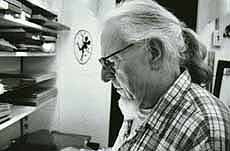
Ed at work in darkroom

The workshop
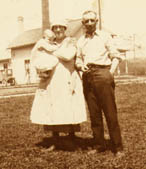
Ed with parents |
Creativity has long been man’s quest for immortality. In the creative act, man confronts this dialectical nature of existence; in art, he finds its synthesis. Penetrating the unconscious nature of his soul, the artist tears asunder all past forms of logic clung to and departs on a never-ending search for eternal truth. Photography, like all forms of creativity, is a constantly evolving medium as every artist comes forth with his soul to discover. From a life of tragedy, Ed Martin has emerged with nothing less than a revolutionary form of photographic expression: poetry for the eye, massaging and caressing past the cerebral to the primal
Born Edward R. Pennington, in Waterloo, Wisconsin, January 18, 1926, he was the youngest of three children of Ernest and Mary Pennington. When Ed was two years old, the Pennington’s left the small town of Waterloo and headed west to Portland, Oregon. In Portland, Ernest and Mary ran a gas station, auto repair shop, grocery store, lodging cabins and restaurant on a piece of property they rented. Playing cowboys and Indians, carving whistles, and building dams in a nearby stream, absorbed much of Ed’s young childhood. Very early on, it was detected that Ed suffered from extreme nearsightedness. Unfortunately, his parents were too unconcerned to purchase him eyeglasses. Ed could see only one foot from his face; beyond was a blur of shapes and colors. Although nearsighted, Ed was able to read. In the first grade, Ed learned to read so proficiently that the following year he tested out of the second grade. Ed’s fondest memories of his early childhood are the long weekend drives his family made to the beaches of Oregon. Twenty years later, Ed would return to these beaches in search of images for his first photography exhibit.
Ed’s father, though very creative and inventive, was not a sound businessman. His financial misjudgments had plunged the family deeply into debt. Ernest was paralyzed by his financial troubles and saw no means for extricating his family from their desperate situation. In 1933, he shot himself in the head. Ed was seven years old. The events surrounding Ernest’s death remain partially clouded in mystery for Ed. Near the time of his father's death, Ed was sent to live with a local delivery man. He stayed for two weeks. Upon returning home, Ed was told of his father's death. Ed was devastated. "He was one of the few people who made me feel good about myself," says Ed. "No matter how busy he was, he always made time for me." This tragedy tore the family apart and altered the course of Ed’s life forever. It would be some thirty years before he would find closure for his traumatized emotions. To this day, Ed does not know the exact date of his father's death.
Ed was sent to live with his sister Mary who was married to John Davidson, a construction worker, thirty years her senior. Davidson frequently moved the family around in search of work. The Bonneville Dam was under construction and many farms along the Columbia River had been condemned by the government as flood regions. The Davidsons lived in the abandoned structures. Ed's daily chores included splitting wood for the stove and carrying buckets of water from nearby springs. Unfortunately, Ed had no close relationships. Though he lived with his sister, their age difference barred the way to a mutual friendship and Davidson wanted little to do with Ed. Any friendships within his age group were usually short lived due to his family's nomadic existence. Ed’s social isolation was detrimental to his coping with the suicide of his father and estrangement from his mother.
Life in Chenowith Valley provided one of the few close relationships for Ed. Chenowith Valley was a small community along the Columbia River with a one room schoolhouse. At the Chenowith school, Ed received a personalized education, as the student body consisted of only seven children. It was not with a classmate that Ed forged a bond, but with his teacher. She was a supporter, motivator and much needed stabilizing force. She fostered an insatiable love for reading, which today remains unabated. She challenged him with books from her personal library - books at a level well beyond those of his classmates. During this time, Ed received his first pair of eyeglasses which became his portal to a new worl. A world, once only described to him or displayed in books, was now his own. The newfound sight inspired an interest in drawing: he had a fundamental need to express the beauty of life through his personal vision.
In 1939, Mary's marriage fell apart. Ed soon returned to his mother in Portland. Still unable to provide for him, Ed’s mother placed a newspaper ad seeking a foster family for her son. One foster family returned Ed to his mother after just two weeks simply because of his introverted nature. Another foster family treated Ed as slave labor: he lived in a small, unheated shack behind the house and cleaned chicken coops for hours after school. Complaining about the cold, Ed was back with his mother. Since the age of seven, Ed spent no more than four months in one place and lived with many different foster families. The unstable life wreaked havoc on Ed’s emotions. Confusion and anger, lead to destructive behavior such as theft, belligerence, and a feeling of abandonment. During this trying time, Ed's mother became ill and was admitted to the hospital. Aware of her grave condition, she continued to run ads for a foster family. One day, Clifford Martin, a root beer salesman, answered the ad. Martin met with Mary in the hospital and agreed to care for her son. Mary Pennington never left the hospital again: she died two years later. Although Ed was living with Martin at the time, her death crushed him. It shattered the hope he had of returning to her one day. During this time, Ed also learned of his sister Gertrude’s suicide. Except for his older sister Mary, Ed had lost nearly his entire family by the age of fifteen.
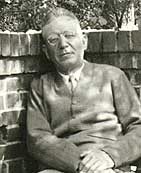 |
Martin, still unmarried, was a very possessive man. He often required that Ed be with him at all times, and constantly expressed his affection for Ed by hugging and slapping him on the back. Being an emotionally closed off and reserved child, Ed felt smothered by his foster father's emotional demands. Martin also orchestrated many situations to denigrate Ed, needing to ensure Ed’s gratefulness. In giving Ed an allowance, Martin always held out the money, only to drop it as Ed reached for it. Actions of this nature would eventually lead to the dissolution of their relationship. |
Clifford Martin |
High school marked a turning point in Ed’s life. The stability Martin provided enabled Ed to develop close friendships; and Ed gradually emerged from his protective shell. However, one event would change the course of Ed’s life forever. One morning, at his foster father's promotional breakfast club, Ed won a door prize. It was a camera. To Ed, it was an instrument of enlightenment for capturing the beauty of the world. Fortunately, Martin had also enjoyed photography as a child and encouraged Ed’s interest. He bought Ed film and chemicals, and taught him to develop film. Ed became obsessed: he devoured every photography magazine he could find; studied the work of Edward Weston - a pioneer in the art of photography. Ed’s first photographic subjects were his dog peeing and trees in the evening fog. Ed began taking portraits for money. From his earnings, he bought a new camera and started experimenting with light and tones. By this time, Ed had his own darkroom and enlarger. He was thirteen years old.
In 1943, America was entrenched in the Second World War. The war caused a sugar shortage and forced Martin to change careers. Leaving Ed behind, Martin headed for the Southeast to recruit labor for the Kaiser shipyards. Ed graduated from high school in the spring and signed up at Reed College for the summer semester. Ed enjoyed college so much that he decided to stay on for the fall semester. Then in 1944, about to be drafted, Ed joined the Army and went to Europe as a still photographer in the Army Corps of Engineers. During the war, Ed photographed bridges along the Rhine and Moselle Rivers for the division newspaper. He also shot documentary work on captured German rail and shipping equipment. The senseless death and destruction of war horrified Ed: he anxiously awaited his discharge. While in the Army, relations with Martin had reached a boiling point. Though great distances separated them, Martin continued to criticize and denigrate Ed. Seeing no reason to continue the relationship, Ed finally broke off relations with his foster father. After the war, Ed was stationed at Fort Monroe, VA where he worked with a civil service photographer until his discharge later that year.
 |
In the fall of 1947, Ed moved to Los Angeles to attend the Art Center School to continue his study of photography. At this time, Maxine Johnson, Ed’s girlfriend in Portland, moved to Los Angeles to live with him. Shortly thereafter they were married. Unfortunately, Maxine hated life in Los Angeles and longed for Portland. After much pressure, Ed capitulated. They returned to Portland; and Ed returned to Reed College. It was at Reed, in 1948, that Ed put on his first one man photography exhibit. Included in the exhibit, were Ed’s photos of downtown Portland and the beaches of Newport, Oregon. The reviews were extremely positive, giving Ed the public affirmation he needed to continue pursuing his art. Dissatisfied with the mundane aspects of the required course work at Reed, Ed left in pursuit of a more creative education. He found it at the Museum Art School (now the Pacific Northwest College of Art) in Portland. Professors like Louis Bunce and Jack McLarty inspired Ed with a passion for a true artistic life. Meanwhile, Ed and Maxine’s marriage was far from harmonious. Ed’s frustration finally reached a breaking point and he moved out. However, after much pleading from Maxine, Ed reconciled their relationship. In 1951 they gave birth to their first child, Merrie Molly Martin.
|
Downtown Portland,OR
- 1948 |
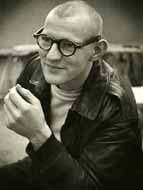 |
| At Reed College - 1949 |
Ten years earlier, fate had delivered Ed his destiny in the form of a camera; life now pulled him away from that destiny. With the birth of their first child, Ed had to leave school and find more lucrative jobs to support his family. The life of a still photographer as exemplified in men like Edward Weston and later his son Brett, is a difficult existence. Over the following years, Ed gradually moved further and further from photography and closer to its distant cousin, cinematography - a more lucrative profession, but for Ed a less satisfying one. Forty years would pass before his return to still photography.
During the next fifteen years, Ed gained further experience in the field of cinematography. In Portland, he met a still photographer, Erven Jourdan, who was based in Los Angeles, but doing catalog work and 16mm industrial films in the Portland area. Ed worked for Jourdan developing film and making contact prints, shooting stock footage, and being a jack-of-all-trades. In September of 1951, Ed relocated the family to Los Angeles and worked with Jourdan for five years, until the company went bankrupt. While working with Jourdan, Ed met Louis Clyde Stoumen who was doing a documentary film on the history of still photography entitled "The Naked Eye." In 1956, Ed signed on with Stoumen at Camera Eye Pictures. Ed worked as the cinematographer on "The Naked Eye" - filming photographers, such as Edward Weston, Weegee, Margaret Bourke-White and Alfred Eisenstadt. He also photographed "The True Story of the Civil War." The former film received an Academy Award nomination; the latter won an Academy Award for Best Documentary Short Film in 1957. Ed remained with Stoumen until his company too went bankrupt. After freelancing as a camera assistant and operator on several television shows, Ed went to work for John Urie & Associates. Ed worked as a commercial cinematographer for Urie for the next five years.
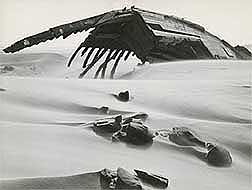
Newport, OR - 1948 |
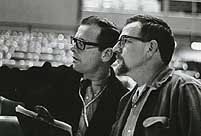
Ed (r) with director |
Meanwhile, the Martin's gave birth to four more children: Ned Manuel (1952); Penny Pennington (1953); Amanda Netti (1957); and Theo Johnson (1960). Although Ed was providing for his growing family, he was increasingly angered by the direction of his career. Ed’s frustration was mounting. Smashing windows; breaking furniture; and punching holes in the wall; all became expressions of Ed’s inner turmoil. Fearing for her safety, Maxine recommended he see a therapist. Ed consented. Therapy had a profoundly positive affect on Ed’s life. It helped him discover the foundations of his anger. Painful emotions repressed for over thirty years finally found resolution. Sculpting, welding and painting became constructive and creative outlets for redirecting his hostilities. Although Ed was gaining control of his emotional problems, his marriage was falling apart. In 1965, the Martins gave birth to their last child Thea Manuela. However, the relationship between Ed and Maxine had already dissolved. After nearly twenty years of marriage Ed left. Although Ed continued to provide support for the family, Maxine won control of the children and Ed’s relationship with them would be forever distant.
At this time Ed was nearing his fortieth birthday, and was confronted with serious heart trouble, caused by years of stress, smoking and poor diet. Ed had rented an old bank building in Hollywood which served as his studio and living quarters. Then severe angina forced him to check into a hospital. The diagnosis was "cardiac insufficiency" and he was discharged a week later with the admonition to avoid fatty meats. Over the next several years, Ed’s health gradually improved. Fortunately, understanding employers helped him to avoid excess stress, allowing him to continue to work and support his family. Ed was doing well financially and gaining a reputation as one of Hollywood’s top commercial cameramen. Although cinematography was not Ed’s first love, he found satisfaction in the work. He enjoyed the problem solving nature of cinematography. Ed was never satisfied until he perfected every genre. In each scene, he not only wanted to create an exciting image, but also one that revealed truth and internal beauty. Director Stuart Hagmann, who worked with Ed for over twenty years, related a story which further illustrates Ed’s relentless pursuit of perfection. During a shoot for the Ice Capades, Stuart told Ed he dreamed of having a camera at ice level so the skater could jump over the camera as it rolled over, capturing the Triple-Lutz from two inches beneath the spinning blades. At the time, the shot was unheard of. However, a few days later, Ed surprised Stuart as he unloaded a wild looking contraption designed to capture the very shot Stuart had described. Stuart has said that "Ed combines the sculptor's quest for exciting form with the painter's use of color. His eye found more than appears on the surface. He captures the interior of the person and the soul of the moment.
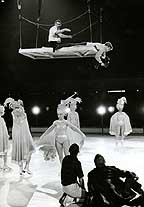
Ice Capades - 1966
|
In 1966, Ed embarked on his most stable years of employment at EUE Screen Gems headed by Dick Kerns. It was at Screen Gems that Ed met his current wife Sandy Kabb. Ed remained with Screen Gems for ten years. After a scandal rocked Screen Gems, Sandy and Kerns left to form another company. Ed finished the last few years of his contract with Screen Gems and went to work for the newly formed company. |
In 1982, Ed was hit with terrible news. His daughter Penny, at the age of seventeen, died of a drug overdose. Because Ed’s relationship with his children was limited, he knew little about what led to Penny's drug problems. Ed’s career, however, was going strong. He received two Clio Awards for Best Cinematography for the IBM commercials "Hats" (1983) and "Skates" (1985). However, as the decade drew to a close, Ed was becoming increasingly frustrated with the commercial industry. Self expression in cinematography was already limited. During the mid 80’s, it became more restricted as agency creatives and clients crowded into the director's chair. So in 1990, after nearly forty years of work in the film industry, Ed retired and finally returned to his first love - still photography.
Free to pursue photography full-time, Ed experimented with many experimental methods of photography. The result was three extraordinary series of works: Mylar, Spirit, and Nature. Ed felt the Mylar series developed his ability to view people in a more subconscious manner. The Spirit series are mirror photographs of a subject. Where the mirrored subject is joined, its spirit is revealed. "I believe all things, whether living or dead, have spirits," Ed says. "When an object is reflected against itself, it is there that you find its soul." The Nature series, however, became Ed’s most innovative and voluminous body of work. Although the Nature series are photographs, Ed does not use a camera to create them. He works with a modified enlarger which acts as a camera/enlarger. Ed places his subjects in the enlarger, manipulates their arrangement and magnifies them up to 800 times their original size. The image is then projected onto photographic paper and processed. His subjects for these images are collected during walks in the Hollywood Hills and along the beaches of Carmel. Brilliant, exotic and haunting images are forged by his combination of antithetical subjects. "I am constantly inspired by the incomprehensible beauty and mystery of nature often hidden from our sight." says Ed. This series has become a metaphorical expression of Ed’s journey through the intricacies of his soul: he no longer looks to the world at large for inspiration, but to the smallest of details within. The voice of another rugged American individualist can be heard echoing throughout Ed’s work - the poet Walt Whitman, who wrote, "the map and design of the biggest things can be seen in the smallest. The whole world in a leaf of grass."
Today, Ed is more at peace with himself as this new phase of his artistic life allows him to express his spirituality directly. He has also begun writing poetry. And, after a lifetime of creative work, he still views the artistic process as a mystical and cathartic experience. Though not formally religious, Ed is closest to Buddhism. "I believe there is no waste in the universe, only transformation of matter and energy. The soul can never be lost." His photographs are a testament to this philosophy; his life a testament to art. In a society of distraction and technological comforts, which serve only to minimize human interaction and self-exploration, art is a necessary form for communicating the beauty of the human condition. Art is our truest expression of humanity; without it we are lost. Ed Martin plunged into dark tunnels of the unconsciousness seeking the universal. He confronted the anxiety of disorientation; devoured faith with porcelain fangs blood stained and dripping; and feasted on the banquet of his soul. Prowling through fevered nights in search of lost thoughts cruel and primitive, he has returned: a phantom back from the precipice, with eternity in his eyes.
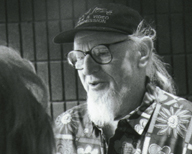
Ed at LA exhibit - 1998 |
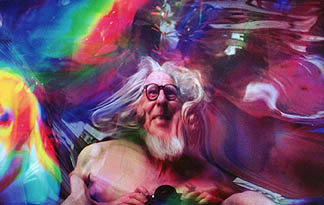
Self portrait in mylar |
 |
|
© 2008 The Martin Gallery. All Rights Reserved. |
|